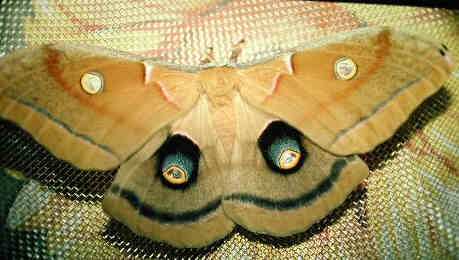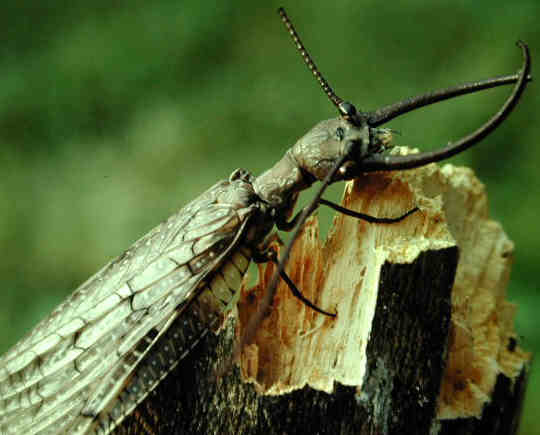| June is Bustin' Out .
. .
Tell you what I like the best--
Long about knee-deep in June,
'Bout the time strawberries melts
On the vine,--some afternoon
Like to jes' git out and rest,
And not work at nothin' else!
--J. W. Riley, From Knee-Deep in June
My June seldom is as laid-back as the June the
great Hoosier poet James Whitcomb Riley paints in his beautiful poem, Knee-Deep
in June. But then my poems do not approach those of the rhyme master
either.
Still, in June I like a lazy mode, even if I work
at something like frog hunting on a still, hot, and dark night, flipping
a minute, slow-sinking fly for bluegills late on a still summer afternoon,
or fishing with miniature setlines for bullheads when an afternoon rain
has muddied the water of a small creek entering a good bullhead lake.
I figure anything I do is worth doing slowly while
I enjoy the ever-present, built-in residuals that come with the warm months
of the year.
Sure, one can find work and get lathered up in
doing almost anything outdoors at this time of year. But making total outdoor
experiences out of any kind of activity will assure success, even if your
primary objective fails.
I think of it as being versatile and studiously
avoiding placing all of one's eggs in the same basket.
"Mix it up and you will love it," I tell myself,
even if my primary objective comes to a complete halt and another activity
takes over.
Take, for example, an afternoon late in June a
few years back when I was wading and bank-walking a small northern Indiana
stream for smallmouth and goggle-eyes.
Depth of the water and steep banks dictated that
I take to the bushes for a short distance. As I slipped through the brush
toward an oxbow on the creek, I was in no particular rush, and that gave
me time to see everything about me. The most interesting facet of the picture
was a huge snapping turtle--well over a foot across the shell--coming out
of the water and onto a sand/clay bank on the far side of the creek.
I wondered what the turtle was up to--coming out
of the water on to a bare creek bank at mid-afternoon. I also knew that
fishing was not so important that I would walk off and leave this mystery
unsolved.
So I deposited my fishing paraphernalia on the
ground and stepped behind some bushes to watch through the little gem binoculars
that are always around my neck in such situations. Being no more than 50
or 60 feet away, the binoculars gave me the feeling that I could reach
out and touch the turtle.
The story started unfolding as the turtle--obviously
a female--propped herself up by using her tail (shorter than most hard-shell
tails) like a hydraulic jack, and started digging a hole in the sandy clay
with her back legs, which were quite long when fully extended.
It was a slow process, and I knew I probably would
have to sacrifice further fishing efforts to see the entire show. But I
realized that I was being offered a ringside seat (stand) for one of nature's
most exclusive dramas. The fishing would have to wait.
It was a slow, arduous job for the old girl and
at times she would stop to rest and appeared to be panting. I wished I
could help her.
But by dropping both back legs into the hole,
that must have been six or eight inches across, she used her claws like
a post-hole digger to excavate the damp sandy clay.
I judged her back legs to be eight to ten inches
long when fully extended into the hole. That told me the excavation had
to be about that deep.
Finally, with her posterior propped up by both
back legs and her tail, the whitish, cream-colored eggs (half or two-thirds
the size of a table tennis ball) were deposited in the hole two at a time.
After several clusters of eggs were dropped into the hole, she would position
them with her back feet.
I tried to count the eggs as they were deposited,
but finally lost count at around 60. Before she had finished I estimated
that there were more than 80 eggs in the nest.
When the last egg had been dropped in the nest,
she raked the excavated (loose) earth over the nest and leveled it off
with her back legs before expelling a large amount of water over the nest,
apparently to further conceal it.
Then she ended her performance by half-running,
half-rolling down the bank at break-neck speed and splashed back into the
water.
Walking back to my car as the sun sank beyond
the trees to the west, I found it difficult to believe what I had seen.
Yet, somewhere among the thousands of 35mm
color slides I have shot while viewing such natural occurrences, there
are several shots of the old girl doing her thing. Ironically, when
I realized the magnitude of the drama I was watching, I had put the 300
millimeter telephoto lens on my camera and was prepared to record the whole
thing on film.
Unfortunately, my camera would not focus sharply
with the big lens and I changed to a smaller lens which was considerably
less effective at that distance. Still more ironic was the fact that a
later inspection of the telephoto lens revealed that a quarter turn of
the lens barrel would have made the focus ultra sharp at that distance.
Photographically, I had blown an experience of a lifetime, but it will
never be erased from my memory.
I can't promise you a nesting snapping turtle
to lure you to the outdoors, but even without such an extraordinary attraction
June offers a wealth of outdoor pleasures. Plunk your bones down near a
stream or river--or anywhere else outdoors (even your back yard)--and you
will be treated to a procession of life.
More recently (last Saturday, June 1, to be more
exact), I walked out my front door to be greeted by a swarm of black damsel
flies, the gaudy males with their coal-black wings and iridescent green/blue
bodies, and the more drab females, identified by the small rectangular
white patch at the outer perimeter of the wings. A walk behind the house
took me into a fast-developing patch of the pale (green stem) touch-me-not,
the juice of which is said to be a deterrent for poison ivy, poison oak,
and some other skin irritants.
Few people--even ardent stream and river fishermen--will
see them. But as the water drops to normal levels on Hoosier streams and
rivers, massive beds of water willow (a weed that reaches a height of about
two feet along the wet banks) will explode with a lavender-white-wine-red
flower that may be our most beautiful wildflower. The flower seldom is
an inch in diameter, but it is composed of four back-to-back blossoms that
look very much like miniature orchids.
To further illustrate the point that anywhere
outdoors can produce a mother lode of natural beauty and interest, take
the case a couple of years back when I found a beautiful cocoon attached
to a leaf from one of my big pin oak trees.
Fearing that the cocoon would be destroyed on
the ground, I picked it up to take it inside. When I moved the cocoon gently,
it vibrated and that whetted a curiosity that placed it on the Lazy Susan
on the dining room table (covered with a screen-wire strainer).
Attempts to identify the cocoon were fruitless,
but a week or so later I found a beautiful polyphemus moth alive and well
under the screen. After a more successful photo session the moth
was released. [See
photos
below.]
Beyond frog hunting, there are many nocturnal
applications for learning about nature. Ponds, lakes and other standing
waters are the homes of many insects, other than mosquitoes, and dragon
and damselflies are prime examples of this life.
Watching the dragons and damsels do their aerobatic
things by day is interesting enough, but if you want to see the big picture
get flat on your belly at water's edge at night to watch an ugly little
black naiad (larva) climb up the stem of a weed (free of the water), take
a death grip, and turn into a beautiful dragonfly.
It is something to behold. As the tissue-paper
like skin of the naiad dries, it splits on the back at the shoulders, and
the head of the dragonfly slowly emerges . . . not greatly unlike the movement
of a hydraulic jack.
Torso of the dragon follows the head and, with
its tail still inside the naiad shell, it hangs head down for a short time
(apparently to gain some strength and give the legs time to develop). Then
it flips up, grasps the weed, and the tail slides out of the shell.
The rest takes time, but the rudimentary wings
develop and dry before daylight and the beautiful new dragon, of which
there are many species in Indiana, is capable of zipping about the pond
and eventually depositing its eggs in the under-water stems of an
aquatic plant, or to simply shake them out by "dapping" its tail against
the surface of the water.
 |
 |
| I found the cocoon (bottom
of picture) in my front yard, and the polyphemus moth (top) was my reward
for saving it . . . The moth emerged on the Lazy Susan on our dining room
table (covered by the screen strainer). Note pin oak leaf to which the
cocoon was attached. |
With wings spread the
multi-colored patches on the rear wing of polyphemus show their beauty.
The patches are almost as large as a dime. |

|
| The dobson fly pictured
above is the adult stage of the hellgrammite, an ugly larva found in streams--one
of the best natural fish baits found in Hoosier streams . . . The large
pincers on the adult are used for mating. The dobson emerges at night,
deposits its eggs on leaves or twigs over water, and dies. Because of its
nocturnal habits it is seldom seen. |
|

